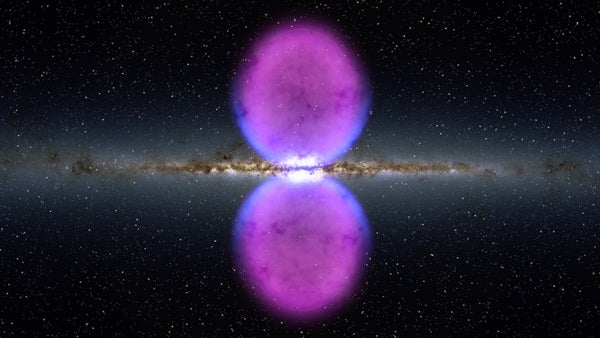The Milky Way appears as a relatively flat structure when viewed along its plane in visible light. Gamma-ray emission, however, paints a different picture: two huge structures billowing outward from the galaxy’s bulge like an enormous hourglass. Named the Fermi Bubbles, these structures are the result of the Milky Way’s supermassive black hole gorging itself on interstellar gas in the past. Using the Hubble Space Telescope (HST), astronomers have now determined just when these structured formed.
A team of astronomers led by Rongmon Bordoloi of the Massachusetts Institute of Technology has used distant quasars to trace the structure and motion of the northern Fermi Bubble, which rises 23,000 light-years above the plane of the Milky Way and contains enough cool gas to create 2 million Sun-size stars. By observing the ultraviolet light from 46 quasars with the Cosmic Origins Spectrograph (COS) on HST (and adding one quasar observation with HST’s Space Telescope Imaging Spectrograph), the team mapped out the motions of cool gas within the bubble to pin down its age: 6 to 9 million years.
Most galaxies contain a supermassive black hole at the center, and our Milky Way is no exception. Sgr A* resides in the Milky Way’s bulge and has a mass equivalent to 4.5 million solar masses. Today, Sgr A* is relatively quiet, accreting slowly as the galaxy ages. By contrast, quasars are young, massive supermassive black holes at the centers of galaxies in the early universe, sucking down huge amounts of gas and dust that shine brightly as the material is funneled into an accretion disk before finally passing into the black hole. Like these younger black holes, astronomers believe that our own supermassive black hole was once more active, at a time when the galaxy was still forming and material was more plentiful for accretion.
Sometimes, though, material doesn’t actually make it all the way into the black hole. Matter can escape along the black hole’s spin axis, exiting the area — and often the galaxy altogether — as huge outflows that span tens or hundreds of thousands of light-years. The Milky Way’s Fermi Bubbles are such an outflow; they were discovered in 2015 and named after NASA’s Fermi Gamma-Ray Telescope, which spotted them.
Learning more about the origins of these outflows requires information about their motion. “We have traced the outflows of other galaxies, but we have never been able to actually map the motion of the gas,” said Bordoloi in a press release announcing his group’s results. The work also appeared in the January 10, 2017 edition of The Astrophysical Journal. “The only reason we could do it here is because we are inside the Milky Way. This vantage point gives us a front-row seat to map out the kinematic structure of the Milky Way outflow.”
As the quasars’ light travels through the bubble to reach Earth, it highlights the gas in the bubble itself, allowing astronomers to determine information such as its chemical composition, temperature, and motion. The “cool” gas in the northern Fermi Bubble, which contains elements such as silicon and carbon, was clocked at 2 million miles per hour (3 million kph) and reaches temperatures of 17,700 degrees Fahrenheit (9,800 degrees Celsius).
Such cool gas is actually likely gas from the disk of the galaxy that has been swept up by and integrated into the outflow itself, which has temperatures of up to 18 million degrees F (nearly 10 million degrees C). It is these high temperatures that cause the gas to shine in energetic light, such as gamma rays.
Once the gas’ velocity — its speed and direction of movement — was measured, astronomers used this data to turn back the clock and pinpoint when the gas started moving. This origin is also the last known “big meal” enjoyed by Sgr A*, which hasn’t managed to suck down such a significant amount of matter ever since.
“What we find is that a very strong, energetic event happened 6 million to 9 million years ago,” Bordoloi explained. “It may have been a cloud of gas flowing into the black hole, which fired off jets of matter, forming the twin lobes of hot gas seen in X-ray and gamma-ray observations. Ever since then, the black hole has just been eating snacks.”










